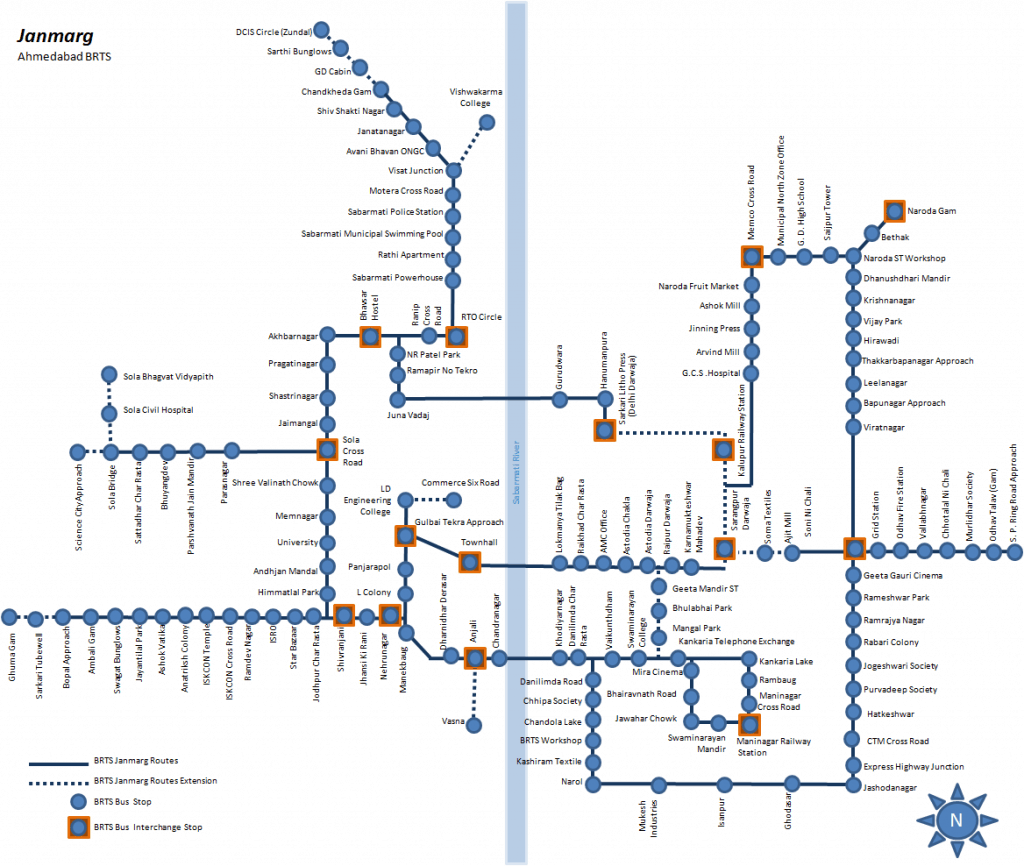“In this humid weather, the ride is really comfortable,” said Harivardan Thakkar, a regular commuter on Ahmedabad’s new Bus Rapid Transit System (BRTS), about the new electric buses introduced into the system from August 29. “Let us see how many such buses and new routes get operational as promised.” Commuters like Thakkar are understandably cautious with their reactions as a number of promises given when the BRTS was launched in 2009 are yet to be fulfilled.
BRTS was introduced with the promise of being a substitute for private vehicles and ensuring last mile connectivity for passengers. Last mile connectivity is still missing and the number of people who shifted from private vehicles to BRTS is not very high. The cycling routes too have not been successful due to various reasons, including encroachments of footpaths.
Despite these shortcomings, Ahmedabad now aims to become the first Indian city to convert its entire fleet of public transport buses into e-vehicles, the first phase of which was launched with 18 electric vehicles running on zero-emission technology. Silent and smokeless, these AC buses with automatic transmission and air suspension have safety features such as automatic fire detection and suppression systems and automatic door sensors which prevent the bus from starting if the doors are left open.
The buses are being run by Ahmedabad Janmarg Ltd (AJL) that manages the city’s BRTS. The BRTS, in the nine years since its launch, has grown from 12 km to 45 km of rapid transport bus routes. The Ahmedabad Municipal Corporation (AMC) incorporated Ahmedabad Janmarg Ltd (AJL) as a Special Purpose Vehicle, to operate the BRTS buses. AJL, registered under the Companies Act 1956 and a 100 per cent subsidiary of the AMC, is designed as a strategic intervention, to attract latent transit demand, improve air quality and help the city remain compact.
Right now, AJL jurisdiction extends to a closed BRT system with median bus stations; specially designed buses with right hand side doors and bus floor and bus station platform heights matching; a complete revamp of the right of way to include cycle tracks and pedestrian facilities; a commercial speed of 25 km/hr enabling faster commuting; and off board fare collection at the Janmarg stations before they board buses. These buses do not have any conductors. Work is still ongoing on some of these facilities.
Short term plans
Ahmedabad Municipal Corporation (AMC) commissioner Vijay Nehra is upbeat about the e-bus initiative. “E-vehicles score high on all the important criteria of a good urban transport system, namely affordability, quality of travel experience and are environment friendly,” said Vijay Nehra. “We did trial runs for more than six months, and are ready to roll it out in a phased manner.”
Nehra shared that in the initial phase, 18 buses were introduced on RTO circular routes 1 and 2 which cover many of the city’s key residential and business centres like RTO Circle, Ranip, Bhavsar Hostel, Shastrinagar, Gujarat University, Andhjan Mandal (IIM), Nehrunagar, Anjali Cinema area, Vaikunthdham Mandir, Swaminarayan College and Kankaria Telephone Exchange. Another 32 buses will be delivered and introduced in mid-October, making the 50-bus order of battery-swap technology-based buses a first ever in India by a public transport company.
While normal electric buses can run up to 200 km per charge, buses with swap facility can run only up to 40 km. Swapping the 600 kg battery after each trip takes just 3-4 minutes as the number of batteries per bus was reduced to increase the number of passengers each bus can carry to 50.
India’s first battery swapping station for public buses (with capacity to charge 12 batteries at a time) has been set up at Ranip, a central spot on Route 1, in Ahmedabad and was recently inaugurated by home minister Amit Shah. The buses are tendered from Ashok Leyland under gross cost model, which means Ashok Leyland will own, operate and maintain the buses, while AMC will pay the company a per kilometre rate and bear only the operating expenses.
“The biggest advantage for AMC is that we have a fast decision-making and implementation system in place for intercity transportation, the Janmarg,” said Vijay Nehra. The AMC board met on September 13th to finalise details for the second phase of EVs introduction, and has ordered 300 more e-buses.
Making Ahmedabad Green
“AMC is the first municipal body to place such a large order with Ashok Leyland and it is also Ahmedabad’s contribution to the Make-in-India campaign,” said city Mayor Bijal Patel. “Till now, the electric buses we saw on Indian roads were mostly made in China. This was the first public transport order made in India. We are dedicated to making Ahmedabad green, therefore the programme for flagging of the buses, and inauguration of the country’s first automated battery charging and swapping station for e-buses by Home minister Amit Shah also celebrated the campaign to plant 10 lakh saplings in the city.”
AMC has put in place systems to ensure punctuality and high frequency of buses. “We will be increasing the number of buses in our BRTS fleet to ensure a frequency of 3 to 4 buses per minute at all the pick-up points,” said Commissioner Nehra. “With this in mind, we plan to order another 300 buses from Tata Motors that will run on fast-charge technology allowing each bus to travel up to 200 kms after each charge.” The AMC tenders stipulated that these buses conform to UBS 2 specifications to ensure optimum quality of air conditioning, suspension and braking system to offer superior ride quality at best prices.
The biggest advantage of e-vehicles is that their running/maintenance costs are low. Compared to Rs 6 or 7 for diesel-run buses, the running expense of e-buses works out to just Re 1 per km. But the capital expenditure on electric buses is almost double that of ordinary buses with e-vehicles costing around Rs 1 crore each, compared to Rs 55 lakh for diesel buses.
The 300 new buses are likely to be procured under the Centre’s ‘Faster Adaption and Manufacture of (Hybrid) and Electric Vehicles (FAME)’ scheme for intra-city operations to promote clean mobility. The scheme is part of the Electric Mobility Mission launched by Prime Minister Narendra Modi.The state government too is supporting this initiative and partly financing the capital expenditure. Under FAME, 5,595 electric buses are to be introduced in 64 cities across the country, though few cities have as yet gone beyond the trial stage with e-buses.


I am not so sure this helps cut air pollution.. The amount of energy required to charge these batteries will produce air pollution.. People just don’t directly see it, so that makes it OK…
When power from Solar panels or wind energy is used to charge these batteries then it does make a big difference to the environment.
but we do have means of generating electricity without using coal and by using tidal, wind and solar that is also the main point of view and comparatively we can empty fuel reserves but not sun and wind that is the whole point of e-buses
When a single automobile engine burns fuel, the overall efficiency is much lower than that of a power plant. Remember that the required fuel also needs to be brought into the cities, which itself burns fuel.
Also, there is huge imbalance between air quality of cities and air quality of suburban areas. Power plants are never located inside major cities. So using battery helps clean the air within the city, which is important for the health of the city dwellers, even if the overall impact may not be as high as it is made out to be.